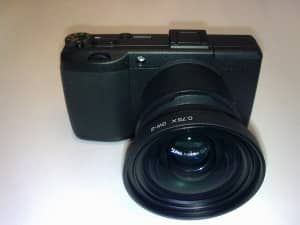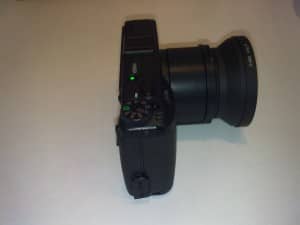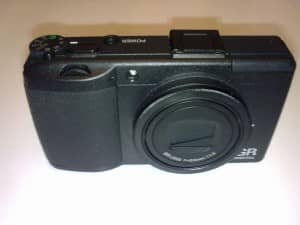Overview:
The Ricoh GR Digital III is a 28mm fixed focus lens, compact digital camera. The sample I have for review comes with the GW-2 0.75x wide angle lens that gives it 21mm focal length. Selling for over £500.00, this neat little camera from Ricoh is in direct competition with some entry level DSLR cameras from the likes of Sony and Olympus. Given Ricohs reputation for quality, can this compact offer something that the entry DSLR cannot? Read on to see if this is the camera for you.
Review:
The camera is fairly compact as compact cameras go, without the GW-2 lens, it weighs about 212g with a battery. It is about 108mm x 60 mm x 26 mm, and is built extremely well. Robust yet lightweight. To the right of the camera all the buttons and the hand grip are located. Despite the large number of buttons on the back, 15 + depending on how you count them, the grip somehow manages to present enough of itself to be useful. The buttons on the top are the mode dial, the up down dial, the shutter release, and the power button. All are easy to reach, and seem solid. The mode dial has a lock button that stops you accidentally switching it to a different position. On the back there is an Adj. button and the usual four way and menu button. There are also playback buttons and two programmable function buttons.

All this is neatly to one side, making way for a 3 inch LCD screen. I am reliably informed that this screen is the best there is a the moment. I don’t know if I can say with any conviction that that is the case, but it is certainly one of the best I have seen. It is sharp, clear, large, and a joy to use even. On the bottom of the camera there are the battery and SD card slots, and a central, metal tripod mount. Back up to the top, and there is a hot shoe and a pop out flash. The flash leads me on to my next topic, the shear number of features, and settings that you have on offer.

Starting with the flash for no better reason than it is on the top of the camera, there are twelve settings that can be selected, giving us more of a clue that the camera is not really aimed a the point and shot brigade, although it will do this as well. You can choose between full, and 1/64, so you can cater for most lighting levels and situations, though being a compact it will still suffer from the flash being pointed forward and nowhere else. Across to the dial, and if we switch to the manual mode you can access all the settings one might expect on a digital camera of this calibre, exposure, ISO, and a raft of features to do with focusing, and white balance. Luckily Ricoh have included three settings that remember various pre-set configurations you may wish to set up, so if you have one of these set up for overcast landscapes, you simply need to switch to that to quickly get the shot.
Some other features that are worth mentioning are the Full Press Snap option and the Dynamic Range Double Shot. The Full Press Snap option overcomes to some extent one of the problems with digital compacts, focusing time. Although this camera is quick at auto focusing, even in the dark, it still will lag somewhat if the conditions are poor. Full Press Snap will take a photo at one of three pre-determined focal lengths if you push the button all the way down, taking a photo whatever. It’s a good idea, and one that is new to the GR Digital III. The next feature, the Dynamic Range Double shot, is not new. I covered it when I looked at the CX1 back in June, but it’s worth going over again. Essentially what this does is take two photos of the same image at different exposures, it then blends these to give you one photo at the optimal exposure for the light and dark areas. A good feature, and produces some excellent results.

The image sensor at the heart of the camera is a high sensitivity 10MP CCD, that is supposed to be better in low light. From the photos I took, it did seem to take a good photo whatever the situation, but if that had any thing to do with the CCD I don’t know. In front of the CCD is the fixed focus lens. Now this instantly gave me a cause for concern, as I like to be able to do a bit of zooming, if not to get close to the subject, then to compose my photos without extraneous background. However, after using the camera for a while it stopped being so much of an issue when you get used to it. You simply need to get yourself positioned in the correct manor before you take the photo. With 10MP, you also have the option of cropping in your photo editing suite. It may be worth mentioning that you can zoom somewhat with a digital zoom included, but I never like digital zooms.
Taking a photo, you have the option of JPEG, and RAW format. It is nice to see a RAW format, and cements the cameras professional image. The RAW format is DNG, so you should not have any trouble in getting the images into any editing software. Shooting in RAW, it take the camera about three seconds to commit the picture to it’s memory, which is pretty good. It will also allow you to take another while this process is taking place, thus giving you 1.5fps for up to five images. In my experience though it take the camera a fair time to recover from such a burst of activity while it writes the photos to memory, and the camera simply blacks out.

The menu is simple and easy to navigate, the only thing that has changed from the CX1 I looked at before is there are a whole load more options to choose from. Aided no end by the crisp clear screen. Speaking of which, I am told that there is an optical viewfinder that can be added to the hot shoe connection, making this compact even more like a DSLR, I don’t know how good it is though. Again as with the CX1 the GR Digital III has a built in level, to aid the taking of a landscape for example.

The Gaj-It Verdict:
Design: 8/10
Usability: 8/10
Features: 9/10
Value: 6/10
We Say:
I like this camera, as it has most things that entry level DSLRs have, and sometimes more. It still suffers from being a compact, but if you think of it as an addition to a photographers arsenal, instead of the sole camera of use, this then makes more sense. Definitely aimed at the professional or enthusiast, this camera has a lot to offer. I might have liked to see some sort of optical zoom, but I guess it is not for that type of photography. You will need to be an enthusiast, or professional to afford it as well as it doesn’t come cheap, but quality rarely does.

One thought on “Ricoh GR Digital III Review.”
I still think the DSC-V1 is much better than this DSLR.